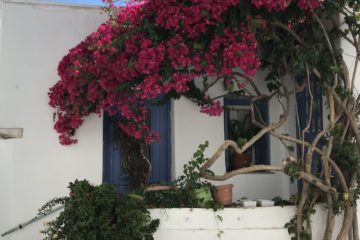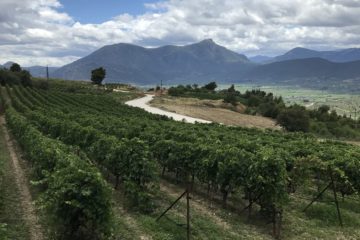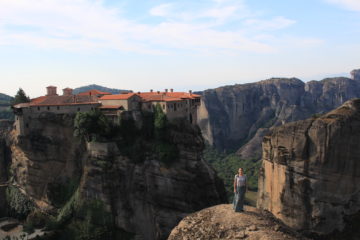When researching Myanmar, aka Burma, we had heard that Yangon (the capital) didn’t have too much to offer other than the main airport for the country, and most travelers skip it altogether. It sounded a lot like what we’d heard about Vientiane, Laos, which was a city where we really enjoyed spending 36 hours or so to see the sites. Fortunately, the same applied to our 36 hours spent in the capital city of Yangon before we headed north to Mandalay, the second largest city in Myanmar.
Yangon
Yangon is an interesting city. We stayed right in the downtown area, and while it wasn’t quite as densely walkable as other cities we’ve seen, we were able to get around on foot just fine. The first night we walked to a street our hostel staff had told us about that had restaurants on it, to find when we got there that the restaurants primarily consisted of plastic chairs set out on the street, inches from any traffic that needed to pass by. We sat down with very low expectations only to be completely blown away by the incredible food we received! I had a tofu and vegetable dish, while Rorie ordered an entire steamed fish with vegetables that was all delivered in an amazing Thai-style broth. We had expected so little and, based on taste alone, it was honestly one of our best meals of the entire trip. On top of that, our waiter was a sweet young man who spoke very good English and was so attentive and helpful, even serving us fish to ensure we wouldn’t get any bones in our bowls. We had a great time talking to him as we ate, and in fact we loved the meal so much we went back to the same restaurant the following night and ordered very similar food. We never do that but it was worth it! [Editor’s note: Not to mention, the other waiters took a liking to us as well and were very excited when we showed up the second night, warmly greeting us and shaking our hands. Our awesome waiter, named “Tortu,” was our first introduction to the warmth and hospitality which was instantly apparent throughout Myanmar. In most of our travels people only speak to us if they are trying to sell something, but here they just genuinely wanted to say hello (perhaps to practice their English or because of the novelty of Westerners) and were also sending friendly smiles our way.]
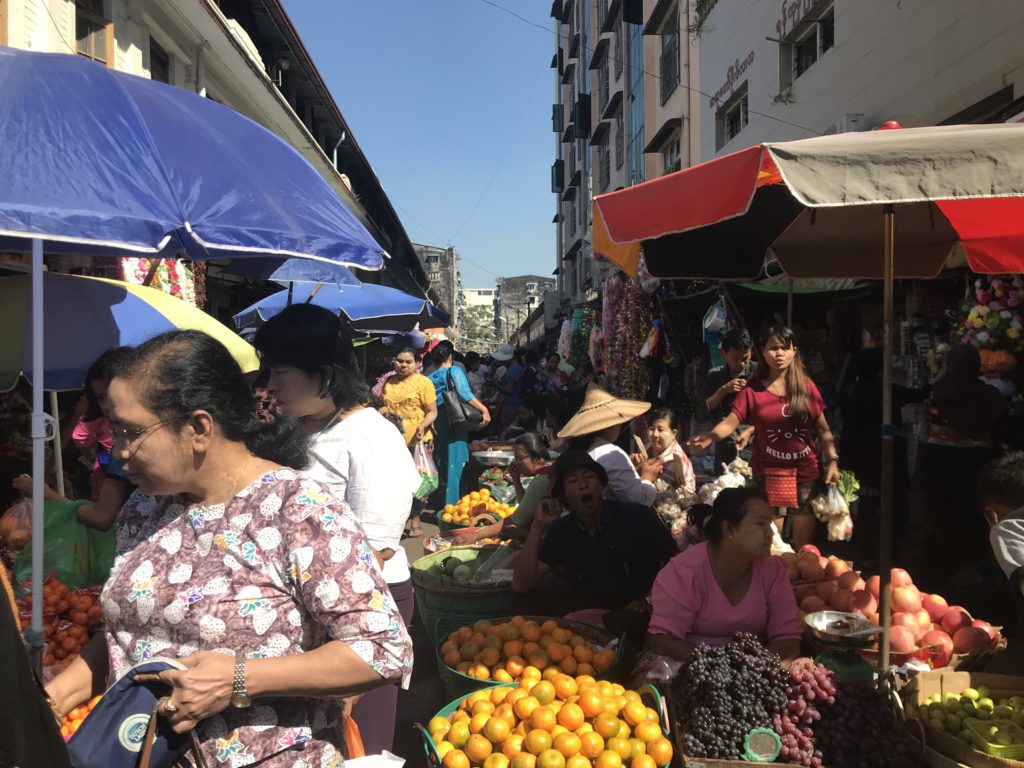
A scene from the street market in Yangon.
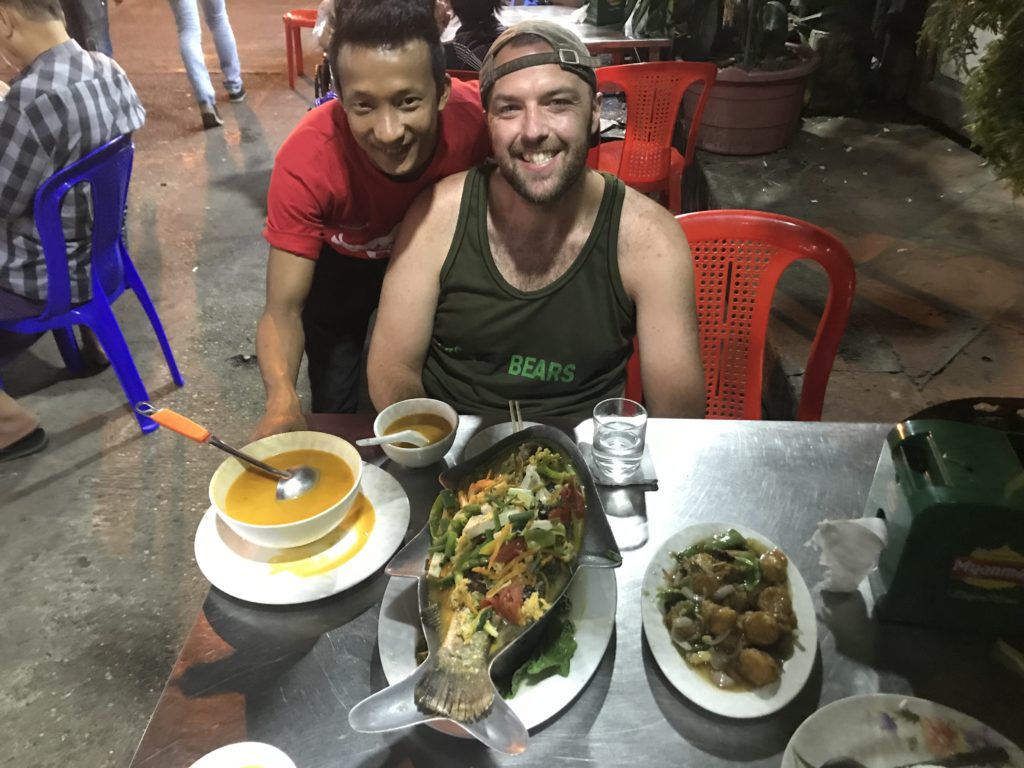
With our awesome waiter, Tortu, and the supremely delicious fish in Thai-style broth. Yummmmmm…
Our one full day in Yangon was spent wandering the city center (it was occupied by the British for about 100 years and has lots of beautiful, old colonial architecture, as well as a wonderfully logical numbered grid street system). We then headed to a large open-air market, where looking for the bathroom led us next door into a totally modern marble-floored shopping mall. One moment, we were walking through dirty streets dodging chickens and women selling platters of fruit from the sidewalk, and the next, we’re looking at the movie listings for the cinema under a giant chandelier. Very strange. Once we did make it to the more traditional market I loved looking through all the beautiful handicrafts, and watching the young monks wearing pale pink robes wandering through chanting and singing, asking for donations from the shop owners. [Editor’s note: The young monks were ubiquitous in the city, which was both adorable and really interesting. People tried to tell us that the pink robes were for female monks, but there’s no way that’s possible – many of them had to have been boys. They would walk in a single file line, led by an older monk, and would sing adorable Buddhist chants, while stopping at the vendors to ask for donations. None of it was overly coercive or pushy – just adorable.]
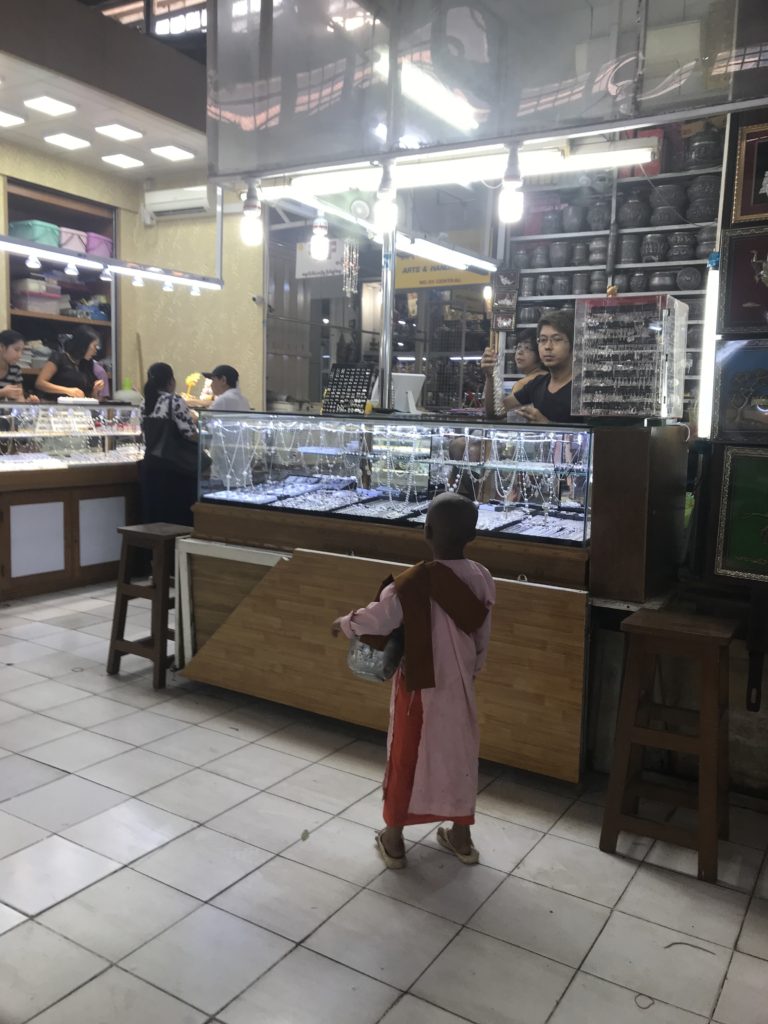
A young monk asks for donations at a stall in the market
Our last stop in Yangon was the main attraction in the city, Shwedagon Pagoda. This is a huge golden pagoda slightly outside of the city center with countless ornate structures, Buddhas, and more gold than I’ve ever seen in one place. [Editor’s note: It’s actually the tallest gold structure in the world at over 360 ft tall, which is pretty cool. It’s basically coated in tons of gold leaf. In fact, for a while each new king would have another layer built and would donate their bodyweight in gold leaf for the purpose of furthering its construction.] It’s stunning, and more so for the relative lack of tourists there. In fact, the vast majority of the visitors were local Burmese tourists there to pray rather than other Westerners like us. We did strike up a conversation with a local man who (upon asking where we were from) told us that President Obama had visited this very temple just a few years ago, then whipped out his phone and pulled up a news photo of Obama at one particular altar, and pointed us to the very spot.
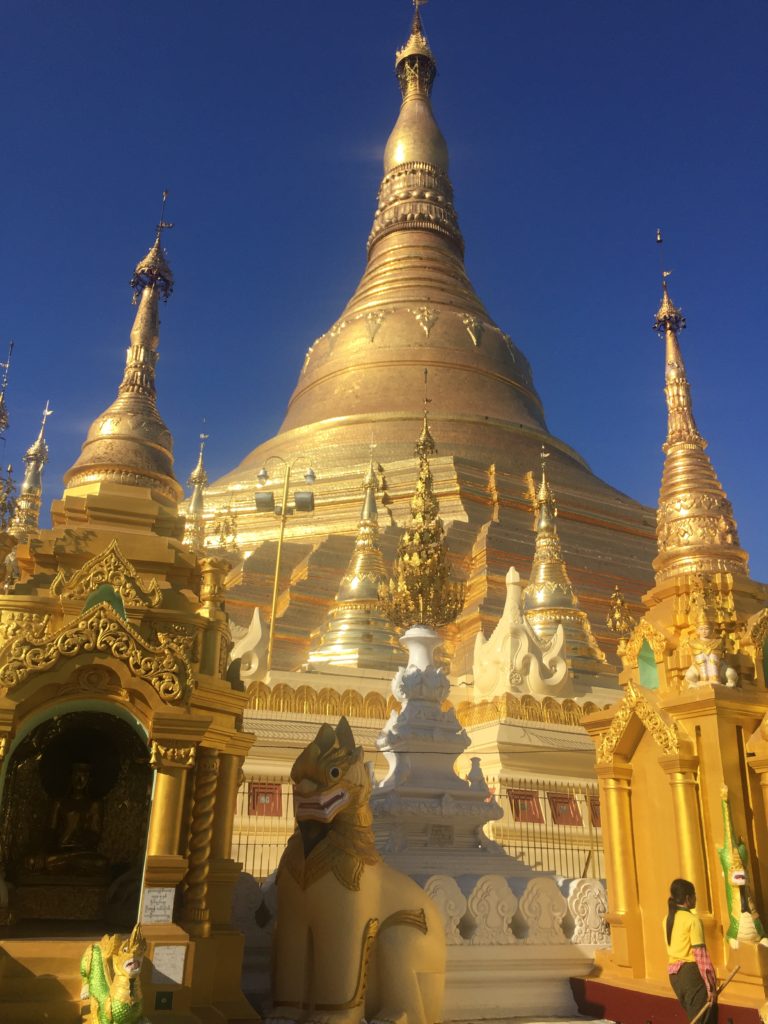
Gold on gold at the Shwedagon Pagoda
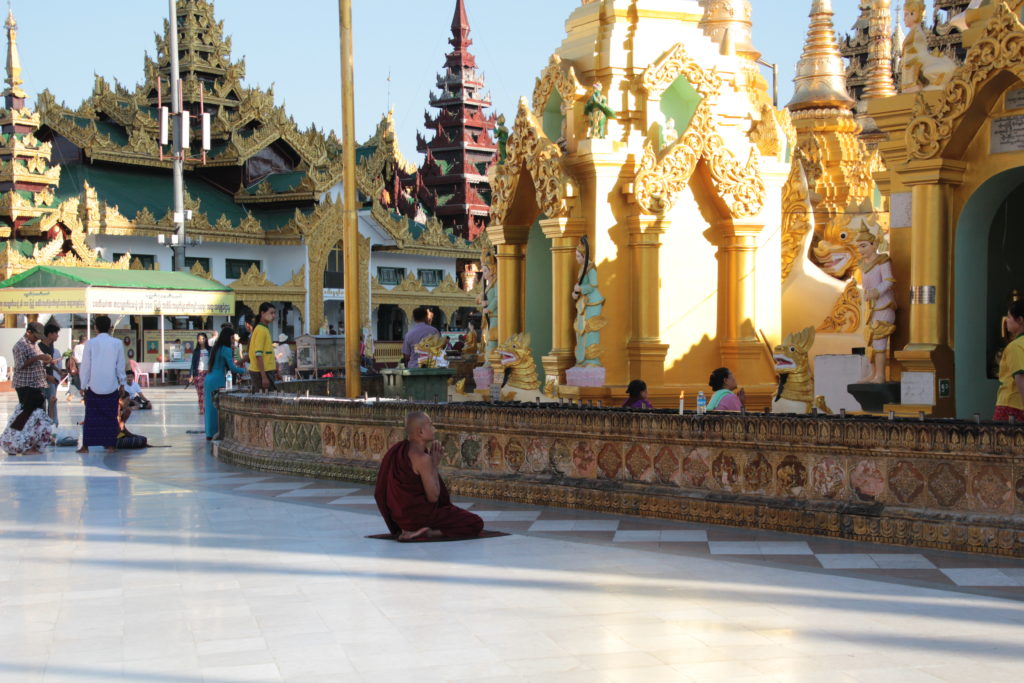
A monk prays among the visitors at Shwedagon
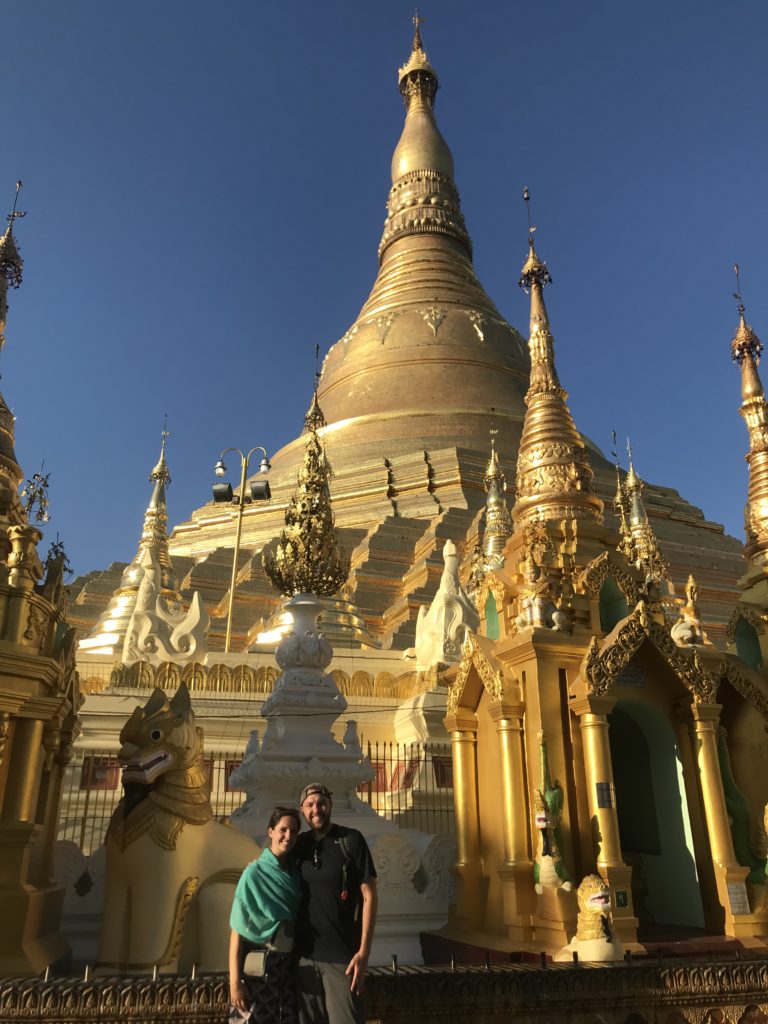
Such a beautiful spot!
Our amount of time in Yangon was just about perfect, I think. There’s not a ton of different activities for tourism, but we really enjoyed our stop through and I’m really glad we got to see a little bit of the city before moving on to Mandalay. [Editor’s note: I agree. I don’t think I’d go back to Yangon to visit, but I’m glad we passed through. It was a good introduction to Myanmar, all things considered, because it contained features that quickly became hallmarks of the country for us, including: a general lack of Western tourists except in a couple of specific cities, extremely dry conditions that put a layer of dirt and dust on everything, incredibly warm, friendly and sincere people that were a joy to be around, men wearing “skirts” (or at least what look like skirts, but which are known as “longyi” and are pretty awesome, and (mostly) men chewing red betel (it’s like a chewing tobacco with spices in it) that makes it look like their mouths are full of blood and that stains the sidewalk red when they spit (truly disgusting).]
Mandalay
Getting from Yangon to Mandalay involved an overnight bus, which turned out to be about as good as an overnight bus can be – we booked one of the most expensive bus companies (which was still not much money) and were rewarded by ridiculously large plush seats with individual TV screens like on an airplane, water and snack bags, and fluffy blankets for our ride. While overnight buses never provide the most restful sleep, this was a far step up from whatever we were expecting! [Editor’s note: Upon arriving, it was interesting to use Mandalay – the second largest city in the country – as a barometer for where the development of the country stands as a whole. The infrastructure was still largely lacking, there were almost no Western eating establishments or even formal stores/markets, there were very few traffic lights and, again, next to no Western tourists. It felt like a city suspended in time, in some respects, and it was far quainter than I had expected.]

Our tuk-tuk to the bus station for our overnight bus.
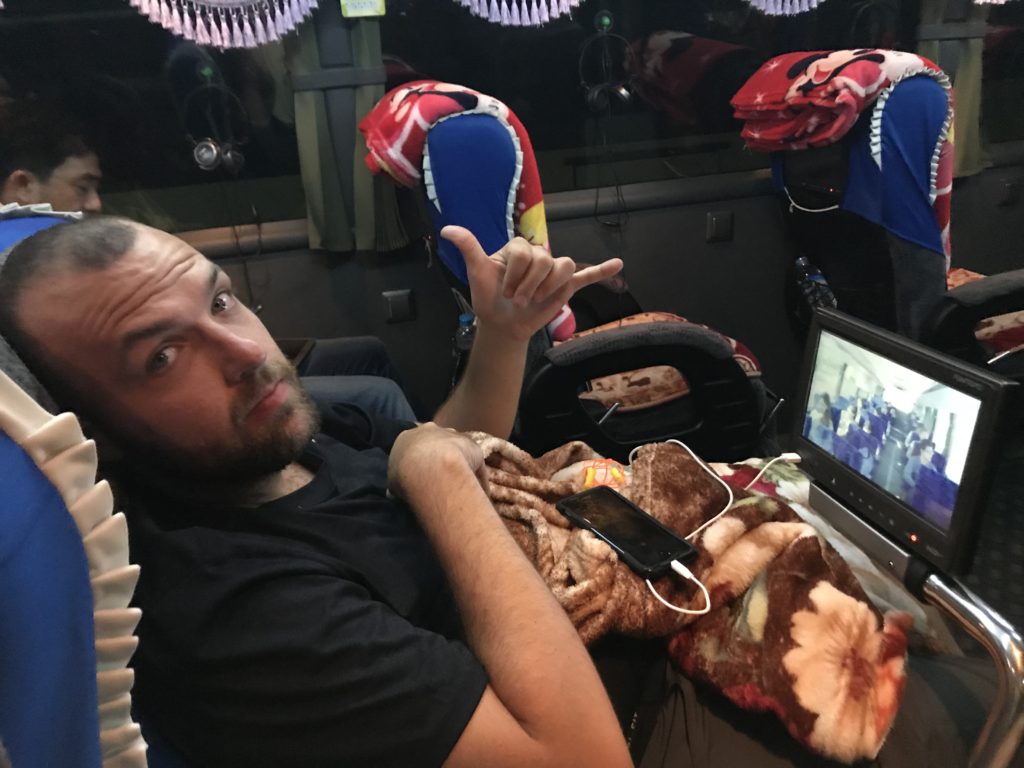
Rorie enjoying his luxury bus seat, complete with TV screen, phone charging port, and fluffy blanket.
We started our time in Mandalay by borrowing bicycles from our hotel to ride through town to a gold leaf factory, as Mandalay is apparently the main (or only?) place in Myanmar where they make gold leaf by hand. Gold leaf is important in Myanmar both because it figures prominently in beautiful handicrafts, but also for religious reasons as many worshippers will purchase a small square of gold leaf to affix to a Buddha statue at certain temples. We got to visit a gold leaf factory and see the manual, back-breaking process by which the sheets of gold are painstakingly pounded thinner and thinner until becoming delicate paper that can then be used as decoration or for worship. [Editor’s note: The workers place pieces of gold between bamboo paper and then, with a monotonous rhythm, pound on this mixture with a mallet so that the combination of the physical force from the strikes, along with the heat they generate (which the bamboo paper retains), spreads the gold out and makes it thinner. Super interesting!]

Men pounding gold leaf in Mandalay.
We also signed up for a day long tour with a private driver (Mandalay isn’t yet on enough tourist itineraries to have standard group tours that we could find) to see a slate of local area sights. We started in town in the stone carving district watching craftsmen carve marble Buddhas with no drawings or guides, free-handing the power tools as we watched. We also saw a wood carving workshop with equally beautiful and intricate work before heading out to a monastery in time for the monks’ lunchtime procession. [Editor’s note: The wood carving was cool because the workers would hold the piece of wood with their toes so that it freed up their hands to carve away at the pieces. They didn’t appear to measure anything or work from a specific design – it was all just in their heads and figured out as they went along, which was super cool.]
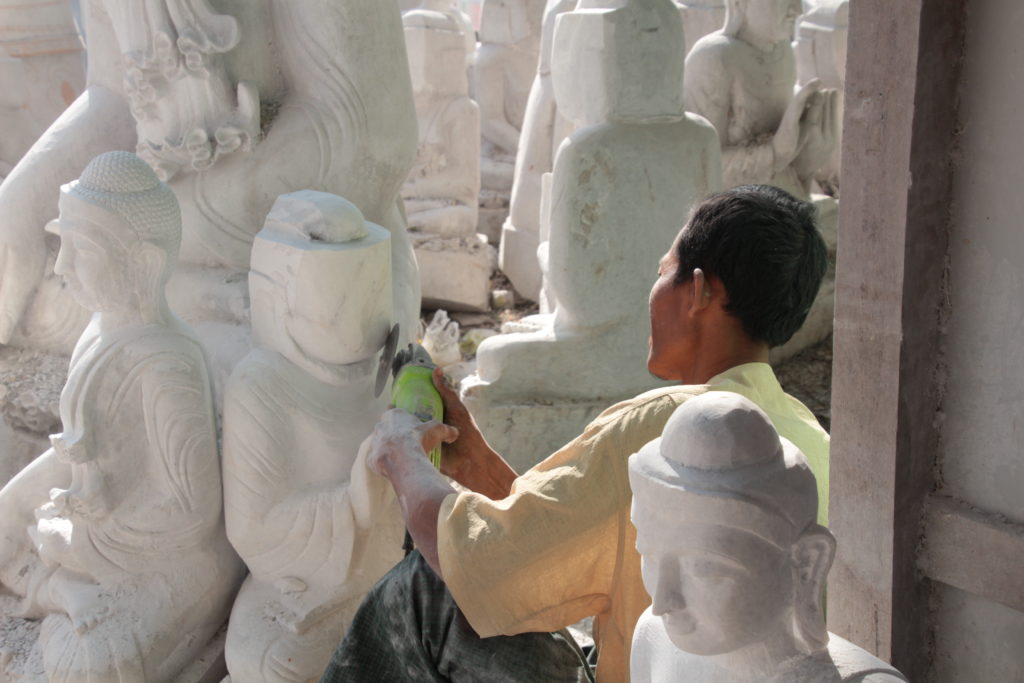
A stoneworker free-hand carves a marble Buddha.
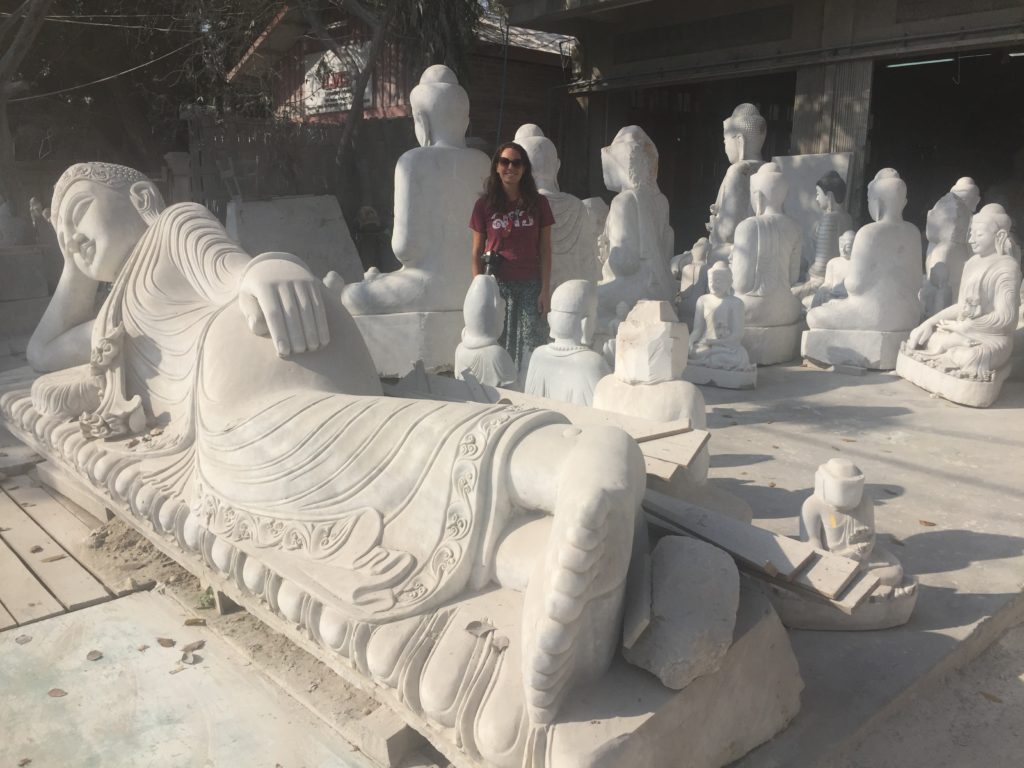
Standing among the in-progress statues
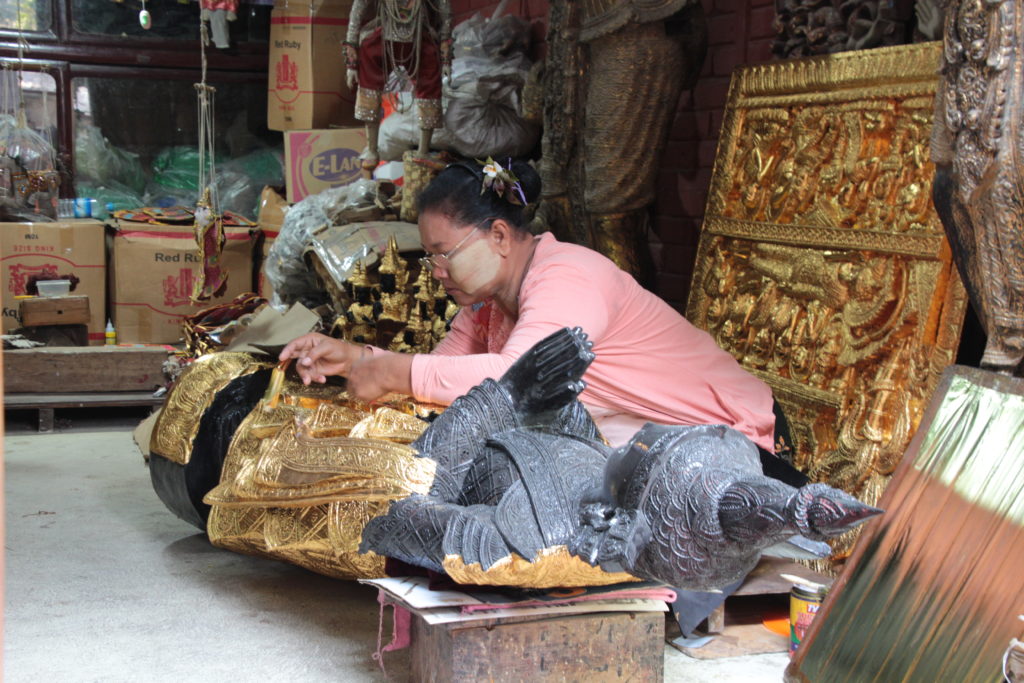
A woman applies gold leaf by hand to a wooden statue at the woodworking shop.
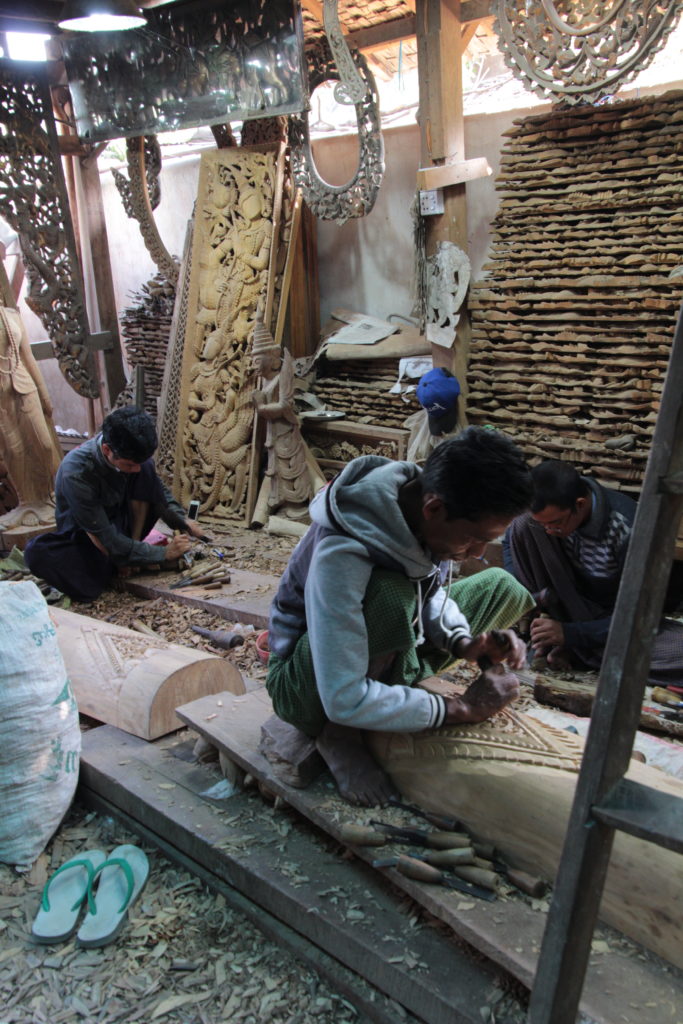
Men carving intricate wood designs.
We got to the monastery in the late morning just in time for the early lunchtime of the monks. All the monks who live at the monastery (over a thousand at this one!) line up in two lines to enter the dining hall, and this procession has become a tourist attraction. As strange as it felt to be watching this custom with my camera out, the monastery clearly embraces the onlookers, and everyone seemed friendly and welcoming. I can only wonder how long this will continue as the country becomes more and more popular with visitors.

Monks line up with their bowls and napkins for lunchtime.
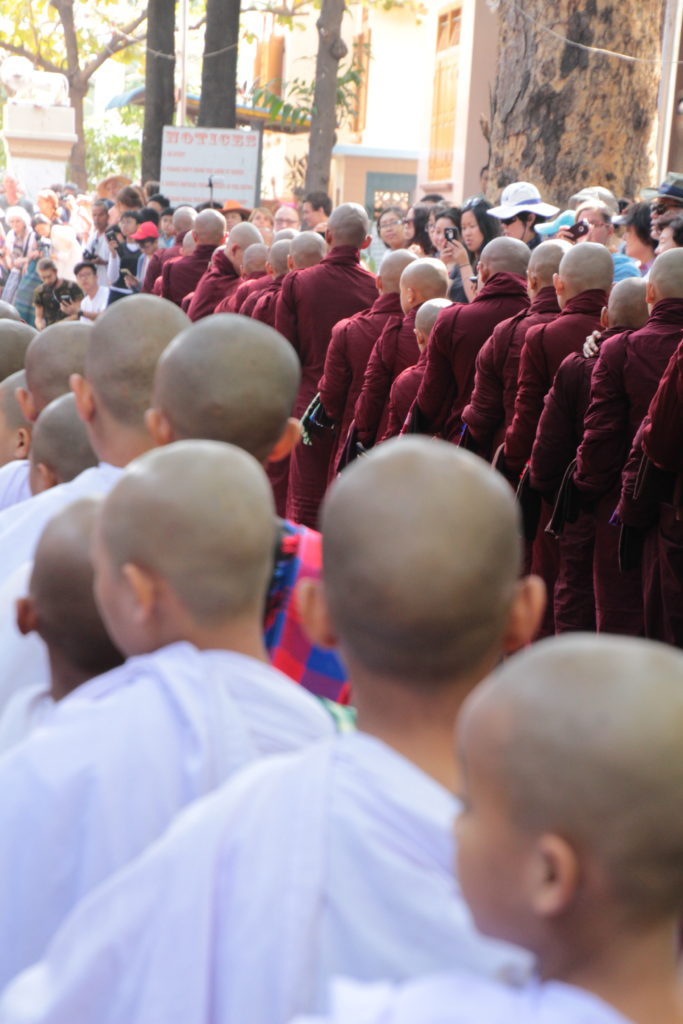
The lunchtime procession of monks.
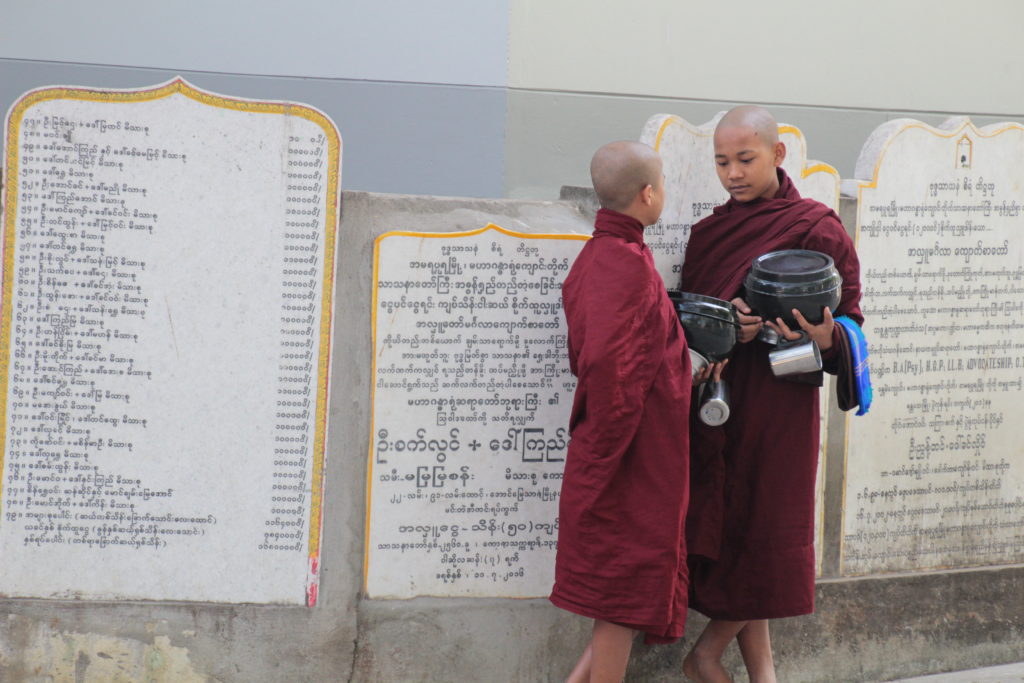
Monks converse before the procession at the monastery.
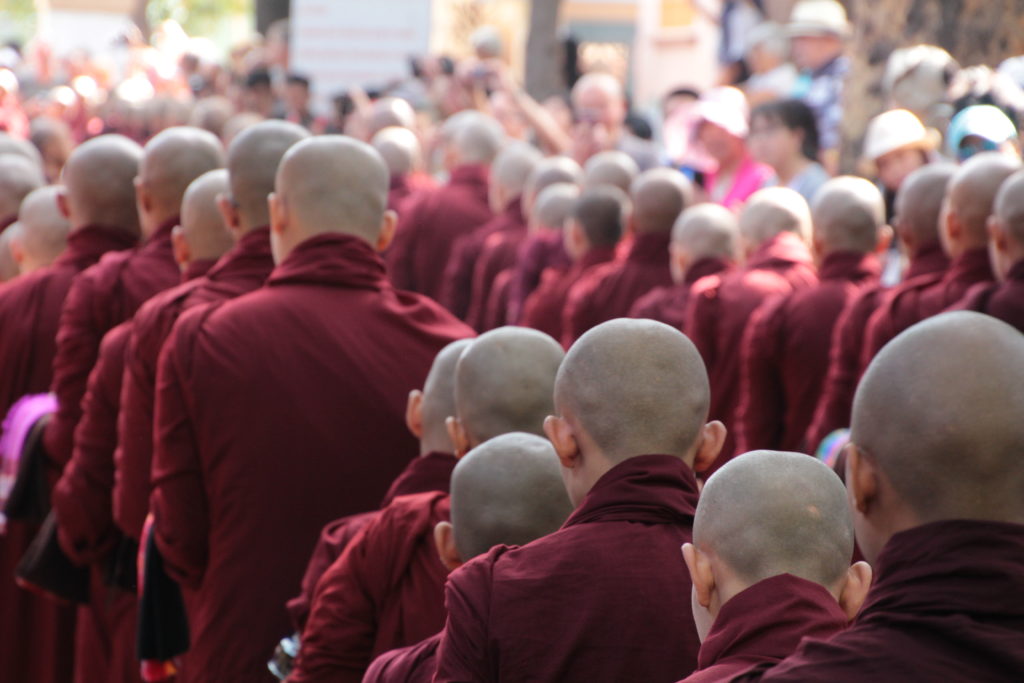
We next headed to a beautiful hillside temple with a gallery of ornate gold statues against a mint green backdrop (every temple in Myanmar has been jaw-droppingly beautiful), and then to another one with colorful floors and a sweeping view over the countryside.
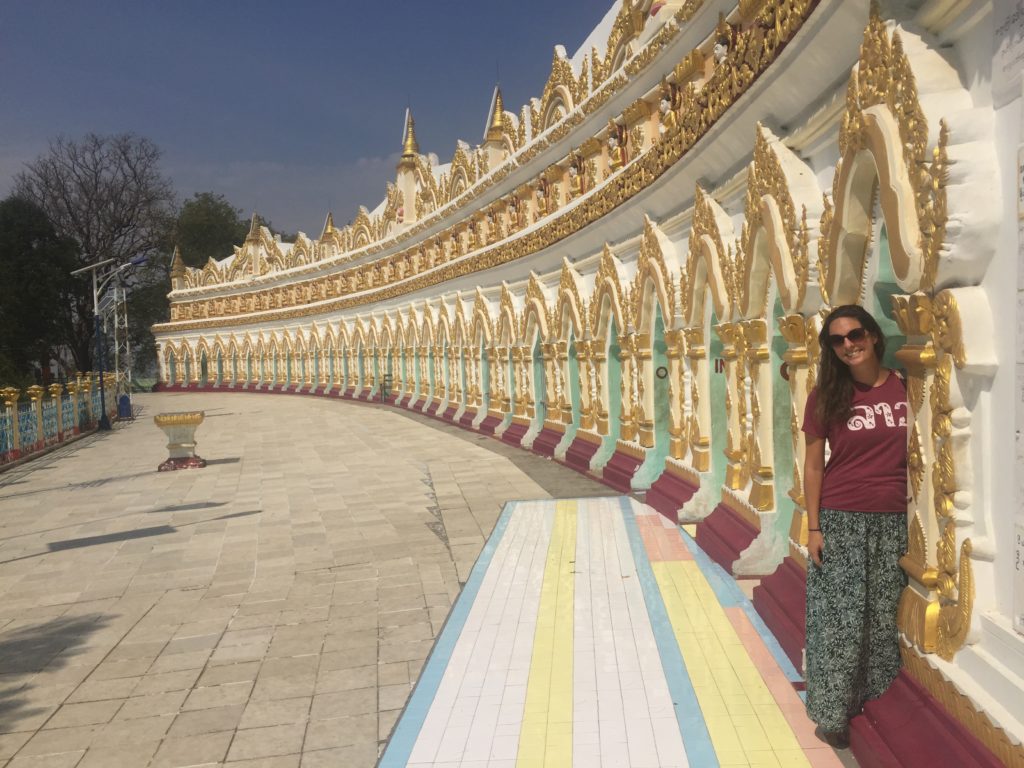
Peering out of one of the doorways of this incredible temple.
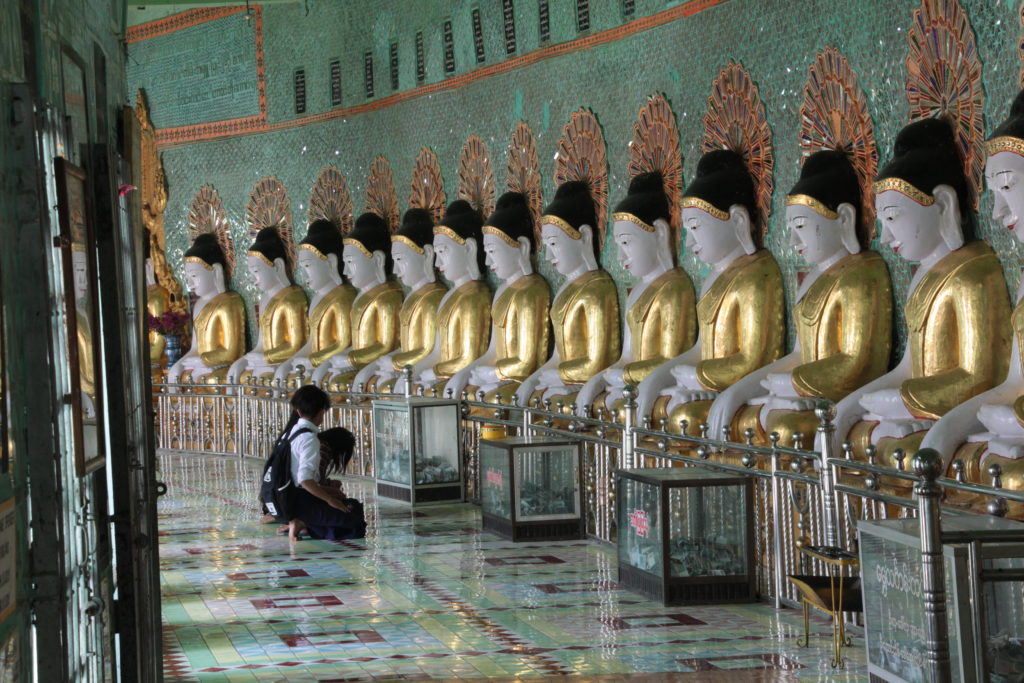
Two women pray in front of one of a line of statues inside the temple.
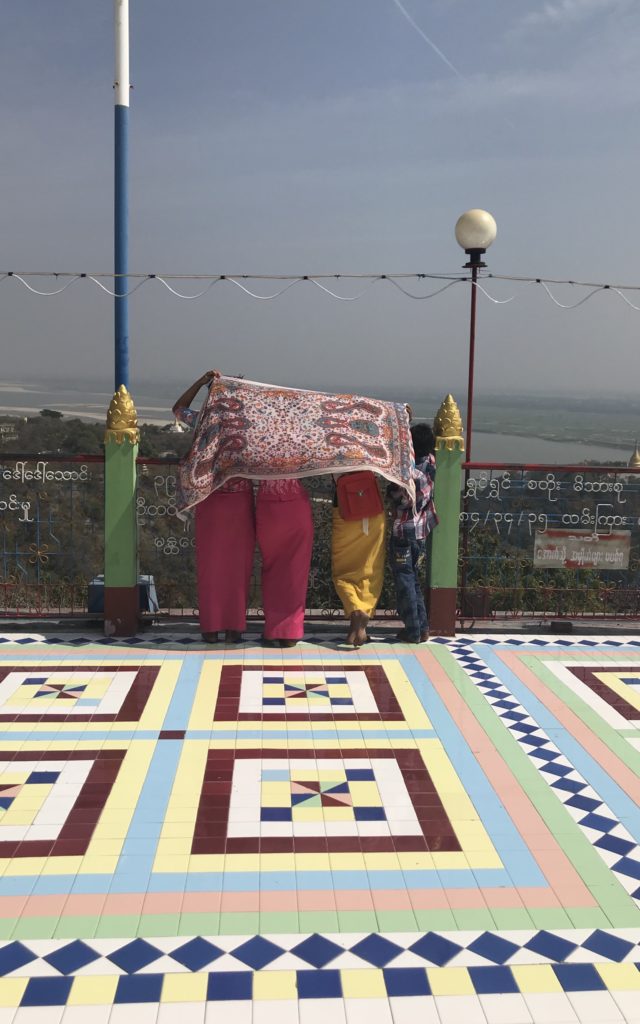
A group of women shield themselves from the sun as they look out over the countryside from the temple.
At this point, a stomach bug Rorie picked up somewhere caught up with him and he headed back to the hotel [Editor’s note: This was the beginning of my downfall in Myanmar. True misery. Thank goodness Jess didn’t get it!] while I continued on to the next site, a village across a river with a number of historic pagodas to visit. After the brief boat ride across the river, I joined up with a solo female European traveler to share a horse cart – the only way to get around to the historical sites. As we bounced around over the potholed dirt road behind our horse named Minywe and our enthusiastic driver who spoke zero English, we had no idea where we were going, how long it would take, or what we would see when we got there. It all worked out, though, as we were taken to a number of interesting structures, from old worn-down stone ruins that reminded me of Angkor Wat in Cambodia, to an ancient wooden monastery and a leaning watchtower originally put up by the British.
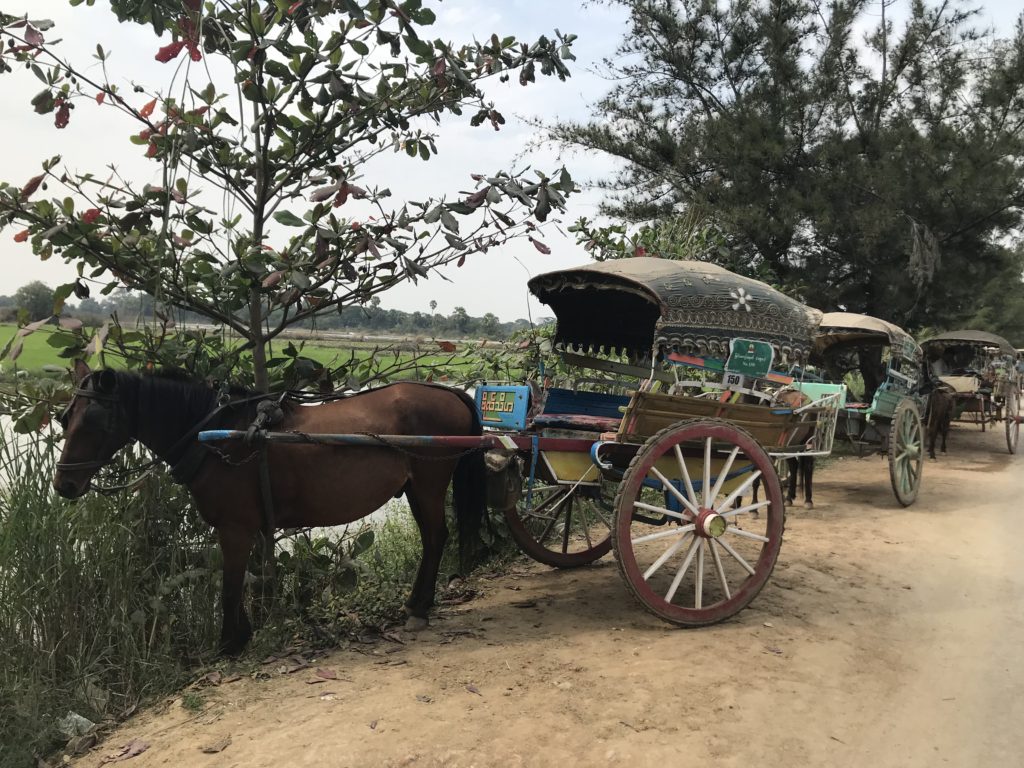
Minywe the horse, my trusty steed for the afternoon.
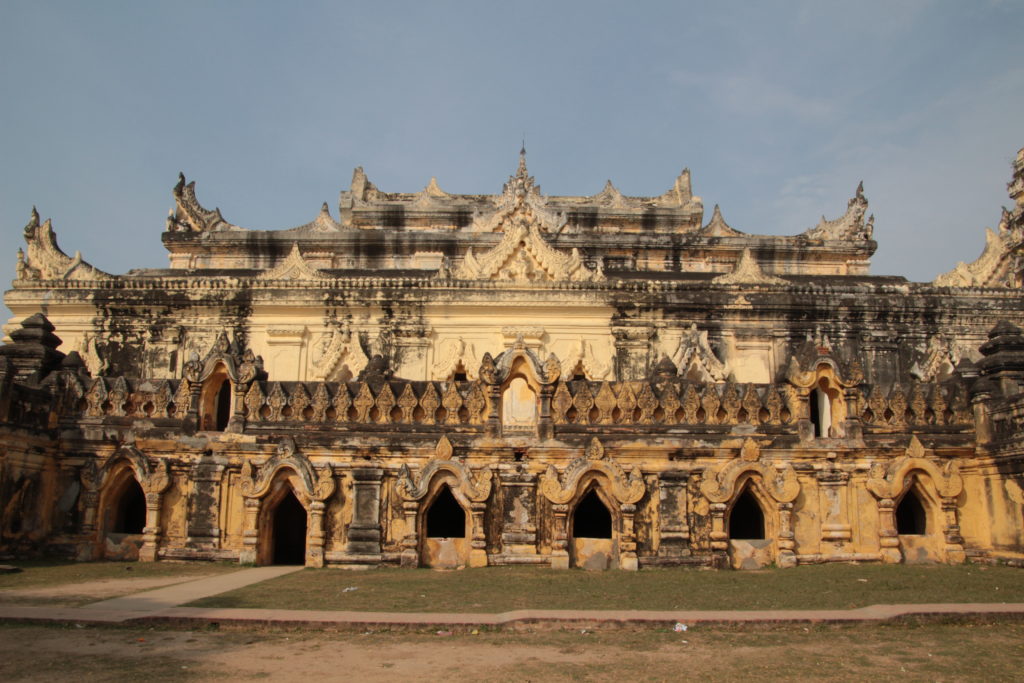
A huge ancient temple we stopped at.
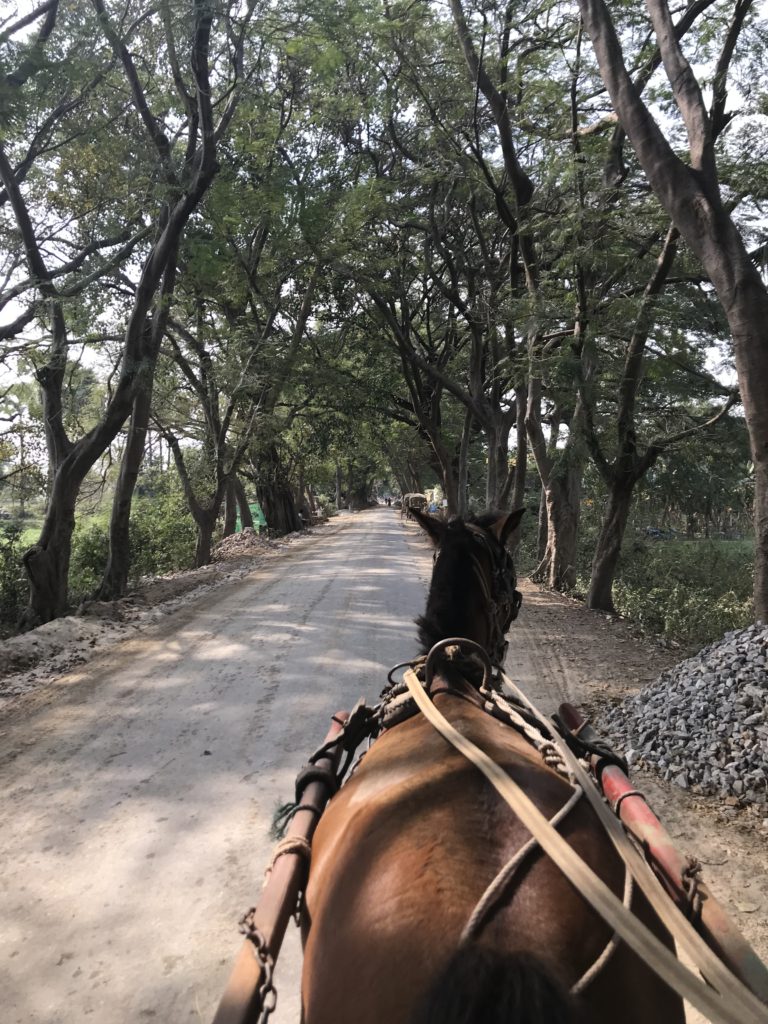
Trotting down a tree-lined path.
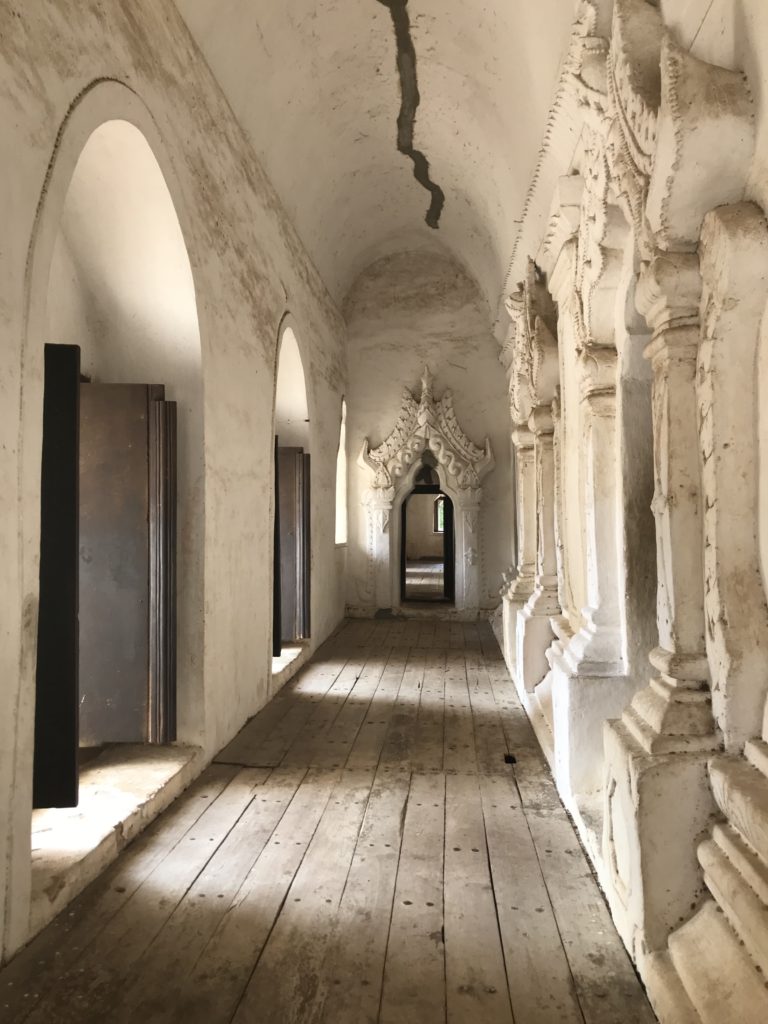
Inside an old wooden temple/monastery.
The final stop of my day was the U Bein Bridge, the world’s longest teak bridge apparently, which is known for good sunset views. Unfortunately I didn’t get much of a sunset because of low clouds, but I enjoyed walking across the rickety structure and looking down at the river and the local life happening on the countryside below. It’s dry season now, which means that the river is relatively small and much of the bridge is actually over dry land, though I was told that during the rainy season the river swells much larger and necessitates the longer bridge length. It was nice to see, though it was clearly quite a tourist trap and designed entirely around huge crowds at sunset. I didn’t completely understand the hype, but as a last stop on a day of activities it was perfectly nice.
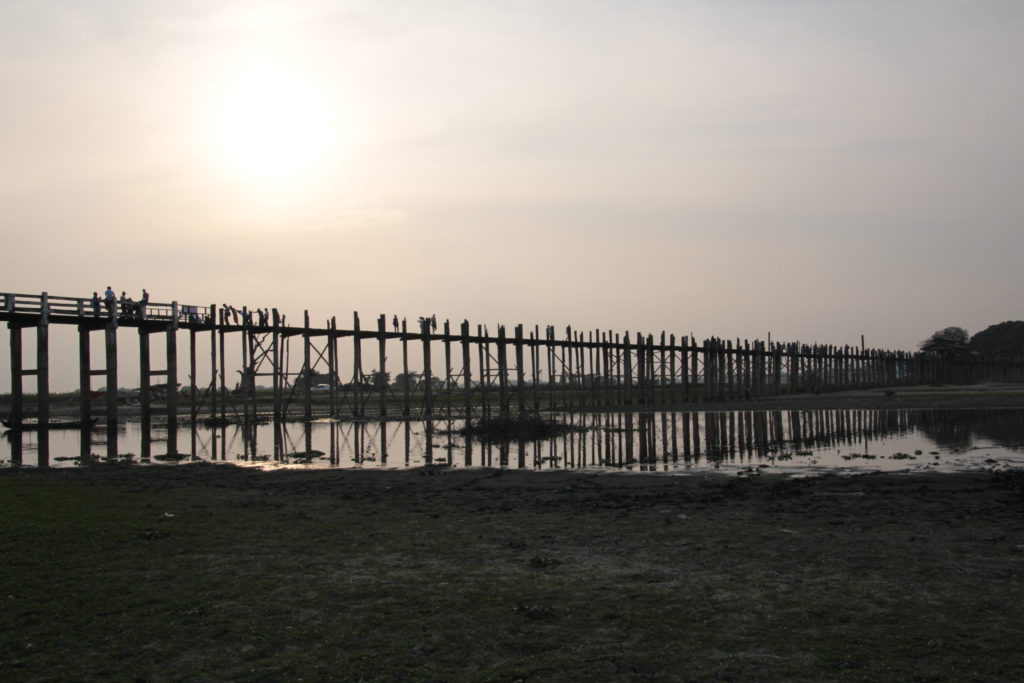
The teak bridge near sunset.
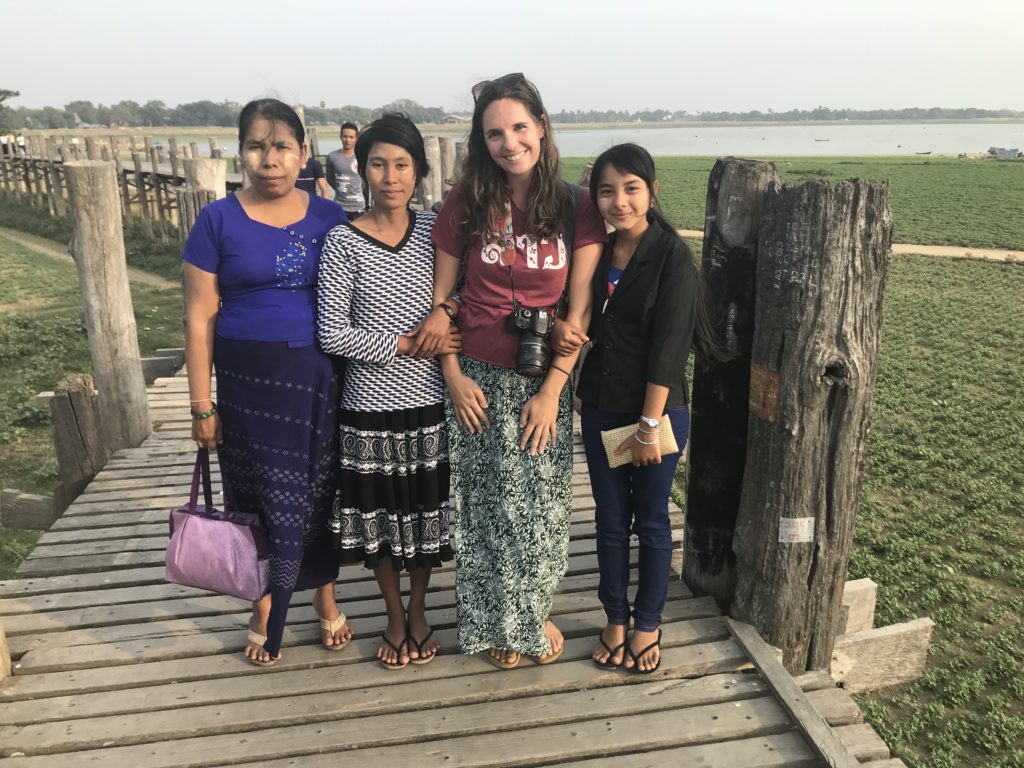
Some local women who asked to take a photo with me on the bridge.
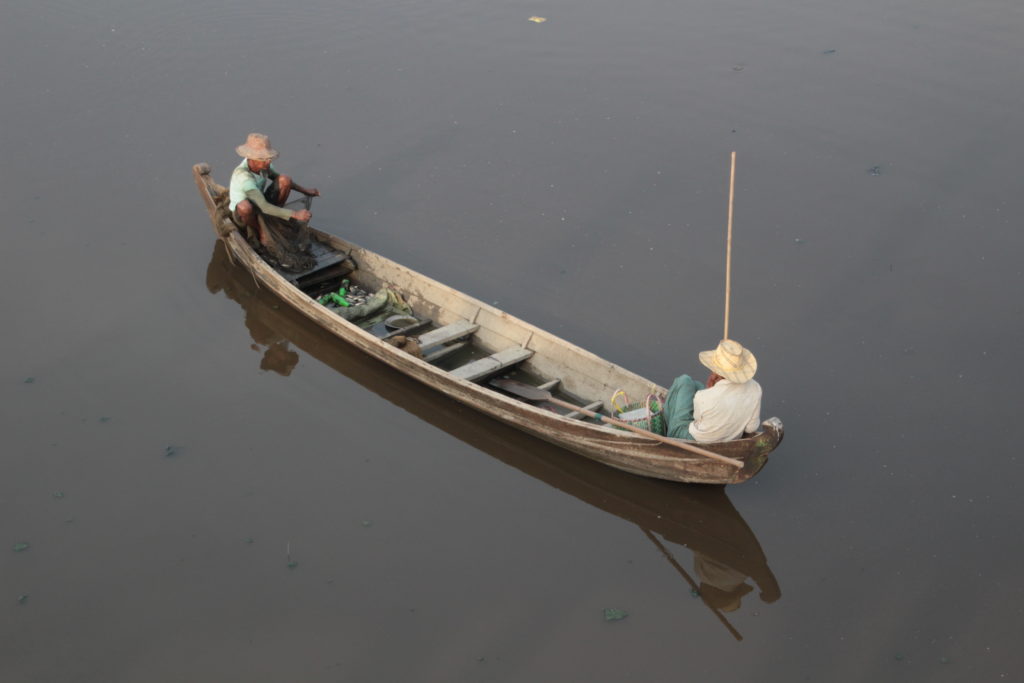
Looking down from the bridge at local fishermen on the river.
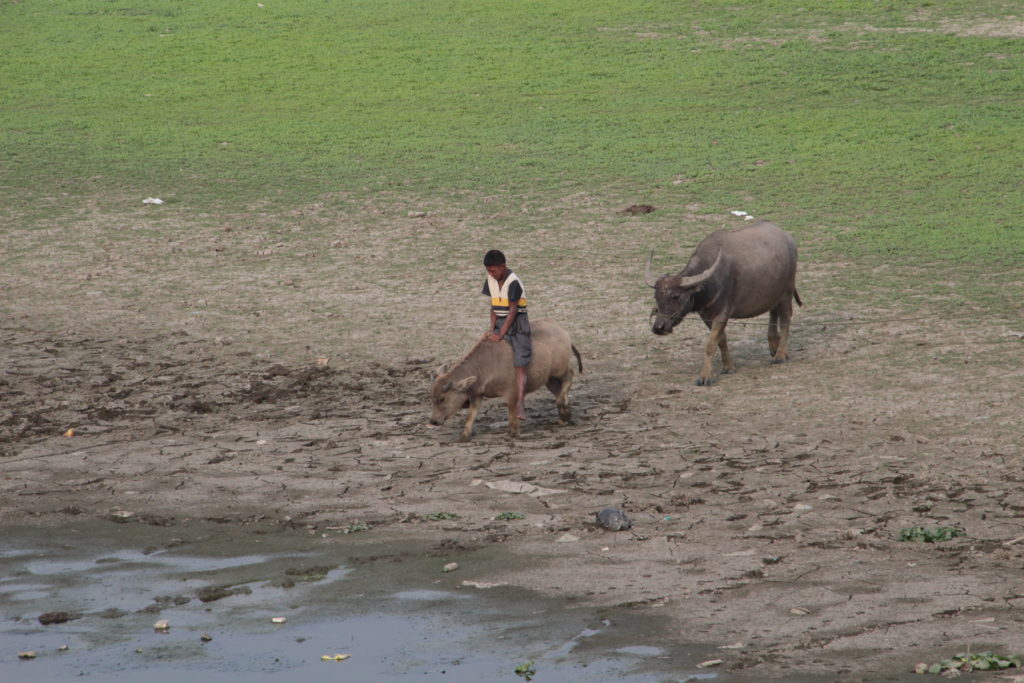
A boy rides his buffalo calf as he takes them to the riverside to drink.
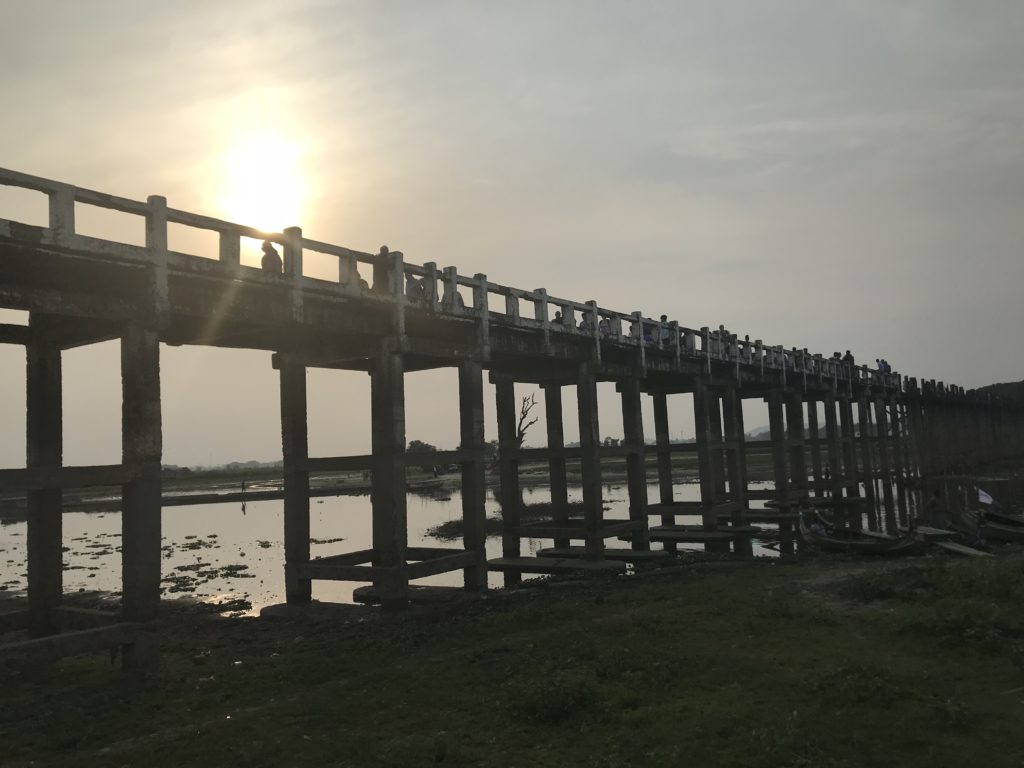
U Bein bridge.
After being asked by several locals to take photos with them (I get asked for photos a lot more when Rorie isn’t around), I headed back to the hotel to join Rorie. Our next stop is the small town of Monywa, another place that many travelers skip but we’d heard has more interesting pagodas and temples in the surrounding areas, and will likely be our least-touristy stop of Myanmar! Will Rorie start feeling better in time to enjoy Monywa? Stay tuned…. [Editor’s note: Nope.]
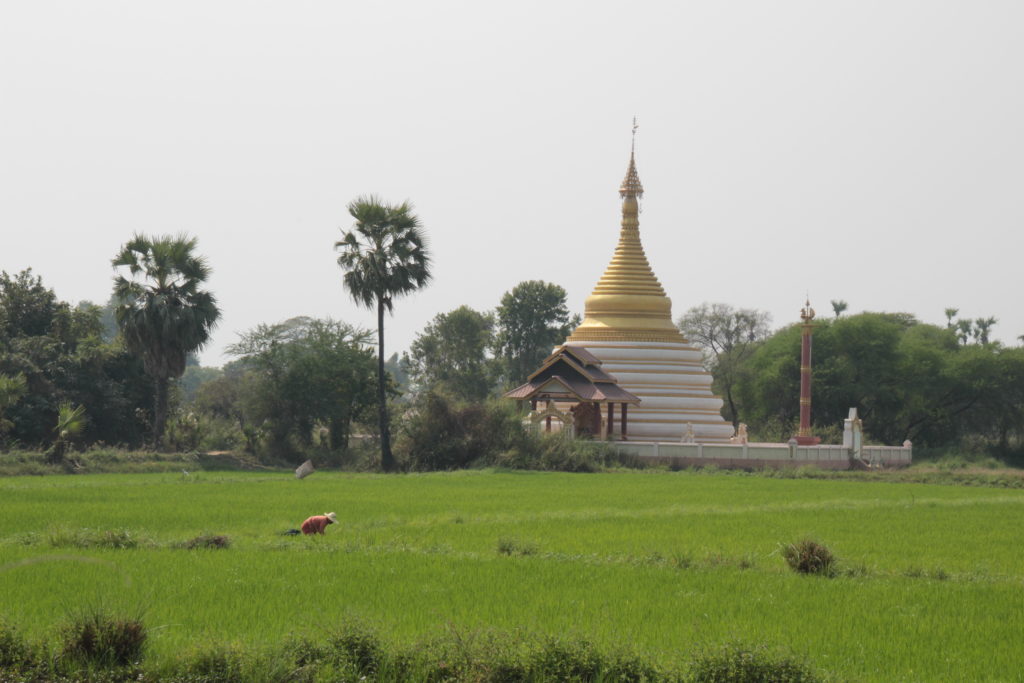
A woman works the fields in front of a pagoda.
